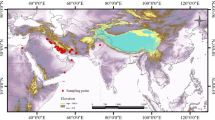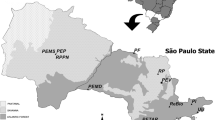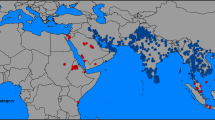Abstract
Several studies have uncovered interspecific latitudinal gradients in abundance (population density) such that tropical species tend to be, on average, less abundant than species at higher latitudes. The causes of this relationship remain poorly studied, in contrast to the relative wealth of literature examining the relationship to latitude of other variables such as range size and body mass. We used a cross-species phylogenetic comparative approach and a spatial approach to examine three potential determining factors (distribution, reproductive output and climate) that might explain why abundance correlates with latitude, using data from 54 species of honeyeaters (Meliphagidae) in woodland environments in eastern Australia. There is a strong positive correlation between mean abundance and latitude in these birds. Reproductive output (clutch size) was positively linked to both abundance and latitude, but partial correlation analysis revealed that clutch size is not related to abundance once the effects of latitude are removed. A subsequent multiple regression model that also considered range size, clutch size and body mass showed that latitude is the only strong predictor of abundance in honeyeaters. In the separate spatial analysis, the climatic variables that we considered (temperature, rainfall and seasonality) were all strongly linked to latitude, but none served as a better predictor of abundance than latitude per se, either individually or collectively. The most intriguing result of our analyses was that the cross-species latitudinal pattern in abundance was not evident within species. This suggests an intrinsic cause of the pattern of ‘rarity in the tropics’ in Australian honeyeaters. We suggest that evolutionary age may provide a key to understanding patterns of abundance in these birds.



Similar content being viewed by others
References
Allen AP, Brown JH, Gillooly JF (2002) Global biodiversity, biochemical kinetics and the energy equivalence rule. Science 297:1545–1548
Ashmole NP (1963) The regulation of tropical oceanic birds. Ibis 103:458–473
Barrett G, Silcocks A, Barry S, Cunningham R, Poulter R (2003) The new atlas of Australian birds. Royal Australasian Ornithologists Union, Hawthorn East
Bennett PM, Owens IPF (2002) Evolutionary ecology of birds: life histories, mating systems and extinction. Oxford University Press, Oxford
Bergmann C (1847) Über die Verhältnisse der Wärmeökonomie der Thiere zu ihrer Größe. Gottinger Studien 3:595–708
Blackburn TM (2004) Method in macroecology. Basic Appl Ecol 5:401–412
Blackburn TM, Gaston KJ (2000) Pattern and process in macroecology. Blackwell Science, Oxford
Blackburn TM, Gaston KJ, Loder N (1999) Geographic gradients in body size: a clarification of Bergmann’s rule. Divers Distrib 5:165–174
Bock CE, Jones ZF (2004) Avian habitat evaluation: should counting birds count? Front Ecol Environ 2:403–410
Böhning-Gaese K, Halbe B, Lemoine N, Oberrath R (2000) Factors influencing the clutch size, number of broods and annual fecundity of North American and European land birds. Evol Ecol Res 2:823–839
Brown JH (1984) On the relationship between abundance and distribution of species. Am Nat 124:255–279
Brown JH (1995) Macroecology. University of Chicago Press, Chicago
Brown JH, Gillooly JF, Allen AP, Savage VM, West GB (2004) Toward a metabolic theory of ecology. Ecology 85:1771–1789
Cardillo M (2002) The life-history basis of latitudinal diversity gradients: how do species traits vary from the poles to the equator? J Anim Ecol 71:79–87
Christidis L, Schodde R. (1993) Relationships and radiation in the Meliphagine honeyeaters, Meliphaga, Lichenostomus and Xanthotis (Aves: Meliphagidae). Aust J Zool 41:293–316
Clarke MF, Griffioen P, Loyn RH (1999) Australian Bird Count: where do all the bush birds go? Wingspan 9[Suppl 4]:1–16
Cotgreave P (1993/1994) Patterns in species abundances. Sci Prog 77:57–69
Cotgreave P, Harvey PH (1994) Associations among biogeography, phylogeny and bird species diversity. Biodiv Lett 2:46–55
Currie DJ, Fritz JT (1993) Global patterns of animal abundance and species energy use. Oikos 67:56–68
Damuth J (1981) Population density and body size in mammals. Nature 290:699–700
Damuth J (1987) Interspecific allometry of population density in mammals and other animals: the independence of body mass and population energy use. Biol J Linn Soc 31:193–246
Dean WRJ (1997) The distribution and biology of nomadic birds in the Karoo, South Africa. J Biogeogr 24:769–779
Dutilleul P (1993) Modifying the t test for assessing the correlation between two spatial processes. Biometrics 49:305–314
Driskell AC, Christidis L (2004) Phylogeny and evolution of the Australo-Papuan honeyeaters (Passeriformes, Meliphagidae). Mol Phyl Evol 31:943–960
Felsenstein J (1985) Phylogenies and the comparative method. Am Nat 125:1–15
Ford J (1978) Intergradation between varied and mangrove honeyeaters. Emu 78:71–74
Garland T, Harvey PH, Ives AR (1992) Procedures for the analysis of comparative data using phylogenetically independent contrasts. Syst Biol 41:18–32
Gaston KJ (1996) The multiple forms of the interspecific abundance-distribution relationship. Oikos 76:211–220
Gaston KJ (1999) Implication of interspecific and intraspecific abundance-occupancy relationships. Oikos 86:195–207
Gaston KJ, Blackburn TM (1996) Global scale macroecology: interactions between population size, geographic range size and body size in the Anseriformes. J Anim Ecol 65:701–714
Gaston KJ, Blackburn TM, Spicer JI (1998) Rapoport’s rule: time for an epitaph? Trends Ecol Evol 13:70–74
Gaston KJ, Blackburn TM, Greenwood JJD, Gregory RD, Quinn RM, Lawton JH (2000) Abundance-occupancy relationships. J Appl Ecol 37[Suppl 1]:39–59
Griebeler EM, Böhning-Gaese K (2004) Evolution of clutch size among latitudinal gradients: revisiting Ashmole’s hypothesis. Evol Ecol Res 6:679–694
Harvey PH (1996) Phylogenies for ecologists. J Anim Ecol 65:255–263
Harvey PH, Pagel MD (1991) The comparative method in evolutionary biology. Oxford University Press, Oxford
Hawkins BA, Diniz-Filho JAF (2004) ‘Latitude’ and geographic patterns in species richness. Ecography 27:268–272
Hawkins BA, Diniz-Filho JAF, Soeller SA (2005) Water links the historical and contemporary components of the Australian bird diversity gradient. J Biogeogr 32:1035–1042
Higgins PJ, Peter JM, Steele WK (eds) (2001) The handbook of Australian, New Zealand and Antarctic birds, vol 5: tyrant-flycatchers to chats. Oxford University Press, Melbourne
Hillebrand H (2004) On the generality of the latitudinal diversity gradient. Am Nat 163:192–211
James FC (1970) Geographic size variation in birds and its relationship to climate. Ecology 51:365–390
Johnson CN (1998a) Rarity in the tropics: latitudinal gradients in distribution and abundance in Australian mammals. J Anim Ecol 67:689–698
Johnson CN (1998b) Species extinction and the relationship between distribution and abundance. Nature 394:272–274
Johnson JB, Omland KS (2004) Model selection in ecology and evolution. Trends Ecol Evol 19:101–108
Kaspari M (2004) Using the metabolic theory of ecology to predict global patterns of abundance. Ecology 84:1800–1802
Lack D (1947) The significance of clutch-size. Ibis 89:302–352
Lawton JH (1993) Range, population abundance and conservation. Trends Ecol Evol 8:409–413
Legendre P (1993) Spatial autocorrelation: trouble or new paradigm? Ecology 74:1659–1673
Lennon JJ (2000) Red-shifts and red herrings in geographical ecology. Ecography 23:101–113
MacArthur RH (1972) Geographical ecology: patterns in the distribution of species. Princeton University Press, Princeton
Martin TE, Martin PR, Olson CR, Heidinger BJ, Fontaine JJ (2000) Parental care and clutch sizes in North and South American birds. Science 287:1482–1485
Pagel M (1997) Inferring evolutionary processes from phylogenies. Zool Scripta 26:331–348
Pagel M (1999) Inferring the historical patterns of biological evolution. Nature 401:877–884
Poulin B, Lefebvre G, McNeil R. (1993) Variations in bird abundance in tropical arid and semiarid habitats. Ibis 135:432–441
Purvis A, Rambaut A (1995) Comparative analysis by independent contrasts (CAIC): an Apple Macintosh application for analysing comparative data. Comp Appl Biosci 11:247–251
Rapoport EH (1982) Areography: geographical strategies of species. Pergamon, Oxford
Reiss MJ (1989) The allometry of growth and reproduction. Cambridge University Press, Cambridge
Ricklefs RE (2000) Density dependence, evolutionary optimization, and the diversification of avian life histories. Condor 102:9–22
Rohde K (1992) Latitudinal gradients in species diversity: the search for the primary cause. Oikos 65:514–527
Savage VM, Gillooly JF, Brown JH, West GB, Charnov EL (2004) Effects of body size and temperature on population growth. Am Nat 163:429–441
Schodde R, Mason IJ (1999) The directory of Australian birds: passerines. CSIRO Publ, Collingwood
Sokal RR, Rohlf FJ (1995) Biometry, 3rd edn. WH Freeman & Co, New York
Stevens GC (1989) The latitudinal gradient in geographical range: how so many species co-exist in the tropics. Am Nat 133:240–256
Symonds MRE, Johnson CN (2006a) Determinants of local abundance in a major radiation of Australian passerines. J Biogeogr 33:794–802
Symonds MRE, Johnson CN (2006b) Range size-abundance relationships in Australian passerines. Global Ecol Biogeogr 15:143–152
Thompson K, Hodgson JG, Gaston KJ (1998) Abundance-range size relationships in the herbaceous flora of central England. J Ecol 86:439–448
Vázquez DP, Stevens RD (2004) The latitudinal gradient in niche breadth: concepts and evidence. Am Nat 164:E1–E19
Webb TJ, Gaston KJ (2000) Geographic range size and evolutionary age in birds. Proc Roy Soc Lond Ser B 267:1843–1850
West GB, Brown JH, Enquist BJ (1997) A general model for the origin of allometric scaling laws in biology. Science 276:122–126
West GB, Brown JH, Enquist BJ (1999) The fourth dimension of life: fractal geometry and allometric scaling of organisms. Science 284:1677–1679
White ME (1994) After the greening: the browning of Australia. Kangaroo Press, Kenthurst
Willig MR, Kaufman DM, Stevens RD (2003) Latitudinal gradients of biodiversity: pattern, process, scale and synthesis. Annu Rev Ecol Evol Syst 34:273–309
Acknowledgments
This work was supported by a grant from the Australian Research Council. We thank Ben Moore, Diane Rowe, Janette Norman, Frank Rheindt, Peter Dunn, Michael Kearney and the Animal Behaviour and Evolution Group at the University of Melbourne for advice and feedback. The comments of Bradford Hawkins and an anonymous reviewer helped improve the manuscript.
Author information
Authors and Affiliations
Corresponding author
Additional information
Communicated by Katrin Böhning-Gaese
Electronic supplementary material
Rights and permissions
About this article
Cite this article
Symonds, M.R.E., Christidis, L. & Johnson, C.N. Latitudinal gradients in abundance, and the causes of rarity in the tropics: a test using Australian honeyeaters (Aves: Meliphagidae). Oecologia 149, 406–417 (2006). https://doi.org/10.1007/s00442-006-0456-6
Received:
Accepted:
Published:
Issue Date:
DOI: https://doi.org/10.1007/s00442-006-0456-6




